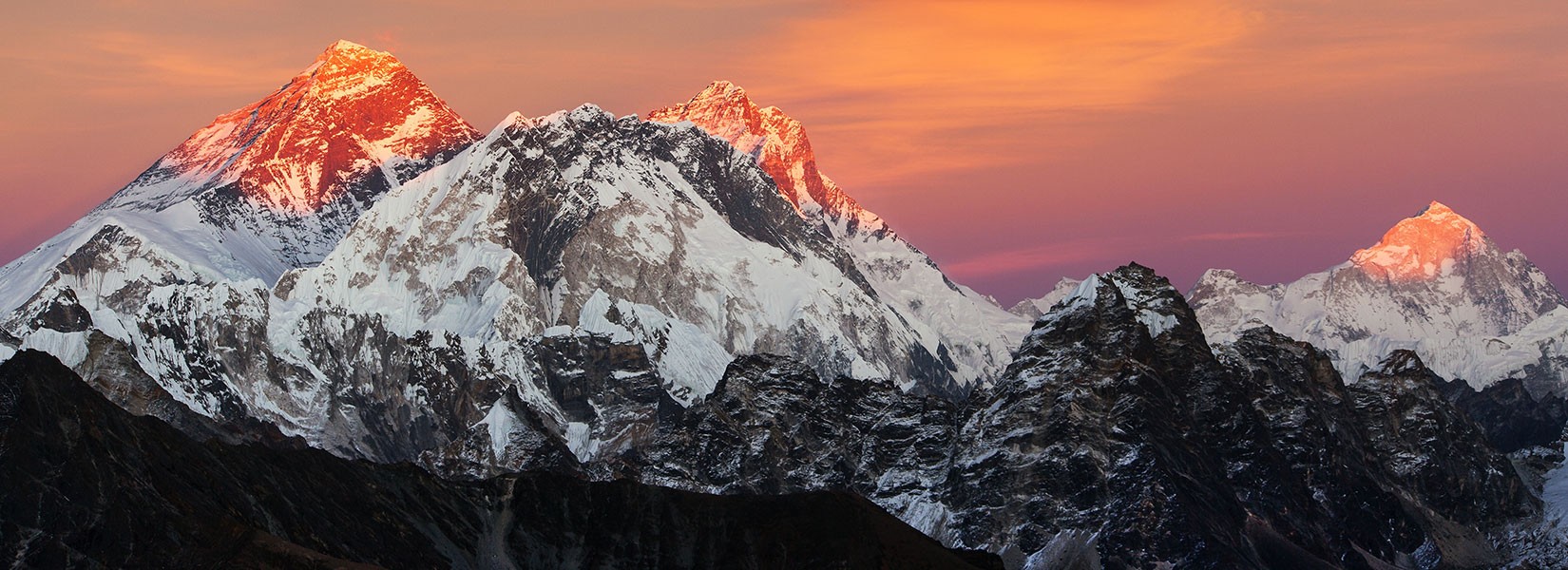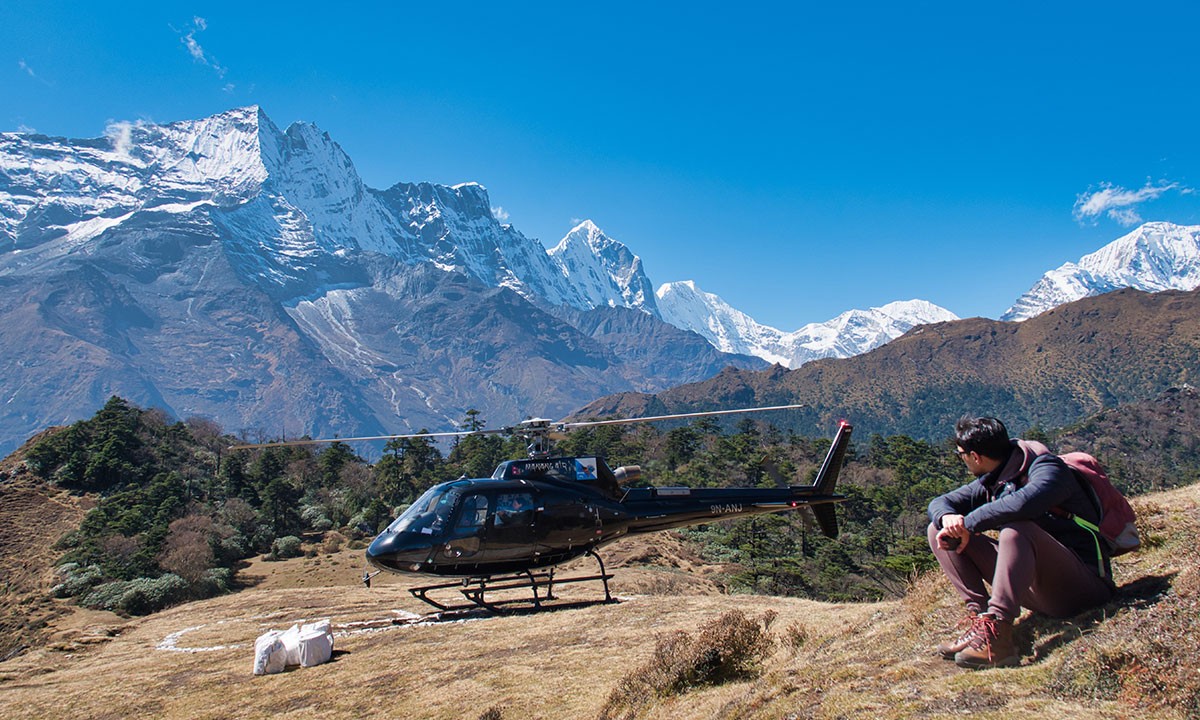 Everest Base Camp Trek With Helicopter Return is a unique and exhilarating exploration of the Himalayas that takes you to the highest base camp in the world, Everest Base Camp (5,364 meters). Unlike other trekking experiences such as 12 Days Everest Base Camp Trek, in this mainstream route that explores the heart of the Khumbu region, this epic adventure ends on a high note with aerial views of the spectacular Himalayas as you fly back to Lukla in a private chartered helicopter. Without missing out on any entails, major or minor, this takes you on one of the most popular trekking routes in the world enjoying its scenic natural trails, relishing the religious and spiritual realms, exploring cultural and traditional prospects, and simply just getting lost in the tranquility of the white-clad gems of mother nature.
Everest Base Camp Trek With Helicopter Return is a unique and exhilarating exploration of the Himalayas that takes you to the highest base camp in the world, Everest Base Camp (5,364 meters). Unlike other trekking experiences such as 12 Days Everest Base Camp Trek, in this mainstream route that explores the heart of the Khumbu region, this epic adventure ends on a high note with aerial views of the spectacular Himalayas as you fly back to Lukla in a private chartered helicopter. Without missing out on any entails, major or minor, this takes you on one of the most popular trekking routes in the world enjoying its scenic natural trails, relishing the religious and spiritual realms, exploring cultural and traditional prospects, and simply just getting lost in the tranquility of the white-clad gems of mother nature.
This unique and adventurous expedition designed by Marvel Adventures makes sure that you have an amazing and gratifying experience without the need to exert yourself during your trek back to Lukla for a return flight. Everest Base Camp Trek With Helicopter Return is an ideal trekking package if you want to enjoy an immersive exploration of the Himalayas in a short time frame and travel all the way back to the starting point trudging your weary body.
Best Time for Everest Base Camp Trek With Helicopter Return
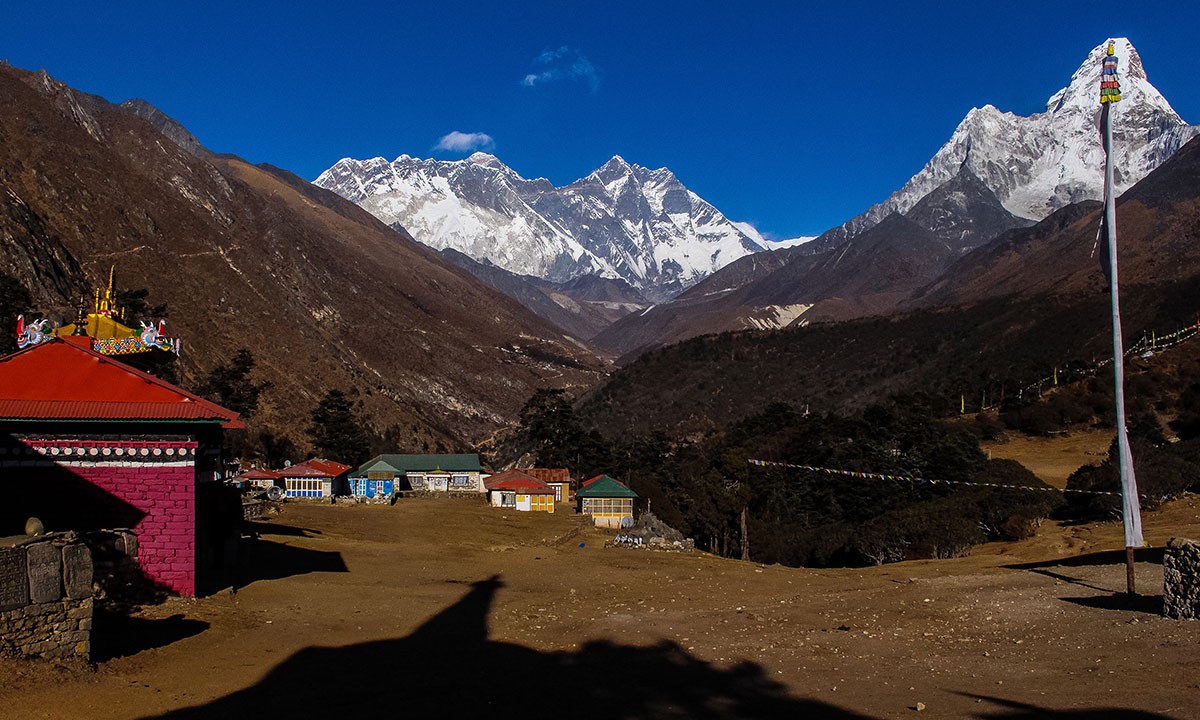
There are generally two seasons that suit really well for the Everest Base Camp Trek With Helicopter Return expedition, autumn (September- November), and spring (March- May). The stable weather during these seasons makes the helicopter flight of the Himalayas more plausible, it cannot be said the same for the off-seasons that have unstable and harsh weather-climactic conditions.
The spring season is best known for its blooming natural trails, the greenery, and colorful trails decorated with wildflowers make the adventure really exhilarating during this season. Ideal for nature lovers, there is a high probability of witnessing the Himalayan flora and fauna during the trekking expedition this season, the entire Himalayan region just simply dazzles you with its allurements in the peak season. The temperature of the Everest region is around 15° C on average during the daytime and can drop upto -5° C during nights and early mornings.
Similarly, the autumn season, one of the most popular seasons for high-altitude exploration in the Himalayan region of Nepal is another peak season that welcomes thousands of trekking enthusiasts from all over the world. The freshness brought by autumn after a heavy downpour of monsoon, the clear wide vistas, mild breezy temperature, and just simply bright and clear days, makes the adventures truly immersive during this season. The temperature of the region hovers around at an average of 14°C during days, whereas at the nighttime it can drop up to -10°C.
Trek Difficulty
The Everest Base Camp trek overall has been graded as a ‘moderate’ difficulty level, trekkers with previous high-altitude trekking experience and good physical condition can easily complete this adventure. Although there are no technical segments that you need to overcome or demand for technical skills to overcome the trail, you will still need to good amount of preparation to complete this Himalayan exploration.
Here are some difficulty factors that contribute to the difficulty level of this epic quest in the Himalayas.
Altitude Gain
With the rise in altitude of this adventure, the risk of altitude sickness also relatively increases. You need to be wary of different types of altitude sickness like Acute Mountain Sickness (AMS), High-Altitude Pulmonary Edema (HAPE), and High-Altitude Cerebral Edema (HACE), and be on the lookout for the symptoms of altitude sickness like:
- Nausea
- Headache
- Loss of appetite
- Dizziness
- Insomnia
- Fatigues
As you start your adventure from Lukla (2,800 meters), you ascend to several high-elevation jump points like Namche Bazaar (3,440 meters), Dingboche (4,400 meters), Gorakshep (5,180 meters) and the highest elevation point of this entire trek Everest Base Camp (5,364 meters). Thus, altitude gain is a significant factor that determines the overall difficulty level of the Everest Base Camp trek.
Trekking Distance
Starting your adventure from Lukla, the total distance all the way upto base camp is approximately 65 km (40 miles), in a round trip, you will have to cover an overall distance of 130 km (80 miles). Thus, this beautiful Himlayane exploration is in no way a short hike, you will have to cover a walking distance of 5- 6 hours on average per day during the expedition. It might not be much of a big deal for those who have experience in high-altitude trekking adventures and are physically active.
But for beginners, who don’t have much of an exercising habit, the long hours of trekking can be pretty much exhausting. Further, the continuously rising elevation makes the long day of trekking even more weary, so if you haven’t prepared for the long day of walking, you might not enjoy this epic quest like you imagined.
Remoteness
You need to understand that Everest Base Camp Trek With Helicopter Return is a remote exploration that dives into the heart of the Khumbu region, it is nothing like an exotic gateway vacation destination. So, you have to make peace with the remoteness of this trekking route, there isn’t a transportation mode available on this route, and the teahouses along the route import goods with the help of mules, yaks, and porters. Thus, the region also lacks when it comes to technological aspects, health facilities along the trail, and other basic amenities.
So, you will have to be mentally prepared for all these factors before trekking. Even though the services are moderate to basics, you will be able to enjoy the warm hospitality of the teahouses along the trail run by the natives, eat healthy nutritious cross-cultural meals with somewhat extensive western delicacies, and rest in comfortable warm rooms with bathroom/shower facilities. Wi-Fi and internet services are also available throughout the trekking route, but it might not be what you expect in an urban settlement.
Khumbu Cough
If you haven’t trekked in the Everest region, this might be a completely new term for you, in fact, it is one of the most challenging obstacles during the expedition of the Khumbu region. It is a very common condition among trekkers in the region after getting exposed to the cold harsh and dry air climate of the Himalayan region. That is why the trekkers are recommended to wear comfortable and warm clothes, stay hydrated, and acclimatize properly with the rising altitude. If by any chance you catch the Khumbu Cough, it can last several weeks and sometimes even months depending on the exposure and physical ability to cope with the condition.
Is This Trek Suitable for Me?
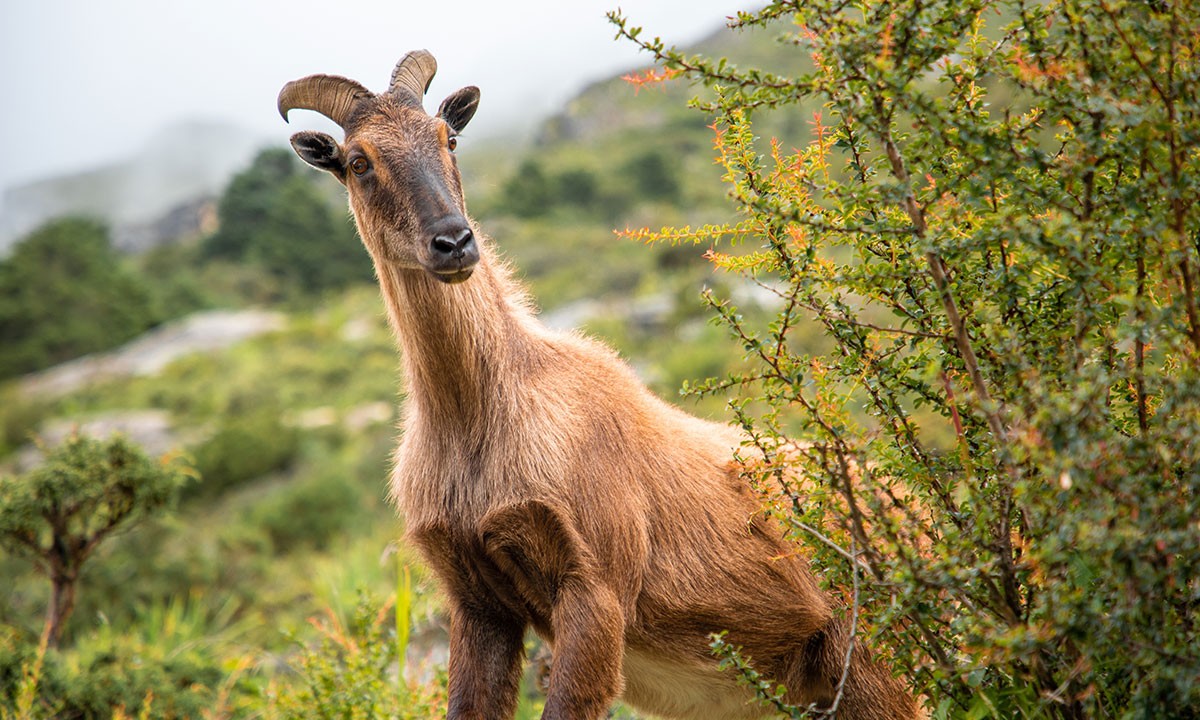
Considering the difficulty factors it is natural for you to wonder whether Everest Base Camp Trek With Helicopter Return is for you or not. Well, rest assured, unlike the mountain expedition of the tallest mountain in the world, this trekking expedition to its foothills is comparatively quite easy. As this trekking is considered a moderately difficult adventure, you will have to emphasize the difficult factors of the expedition and make the preparations accordingly.
You are recommended to have at least a basic level of fitness for this expedition for a more enjoyable and comfortable experience. In case, you are wondering about the age limit, there isn’t exactly an age limit for the Everest Base Camp Trek With Helicopter Return expedition, although this trek is not recommended for children below the age of 10. As for the elderly trekkers, you can consider this adventure depending on your confidence level and health conditions, in fact, trekkers over the age of 75 have successfully completed the base camp trek. As you will return to Lukla directly from Gorakshep via helicopter cutting off the need to trek back the distance of approx 65 km, this adventure will be a lot more convenient and comfortable for the elderly trekking enthusiasts.
Marvel Adventure will make sure you are having an enjoyable and comfortable experience frequently monitoring your physical and health status in this completely guided trekking expedition. You can also easily communicate with your expedition guide and crew members in case of any discomfort or inconvenience. So, join us for this epic Himalayan adventure and we will take every major and minor entails for you so you relish the best value experience.
Preparation and Training for Everest Base Camp Trek With Helicopter Return
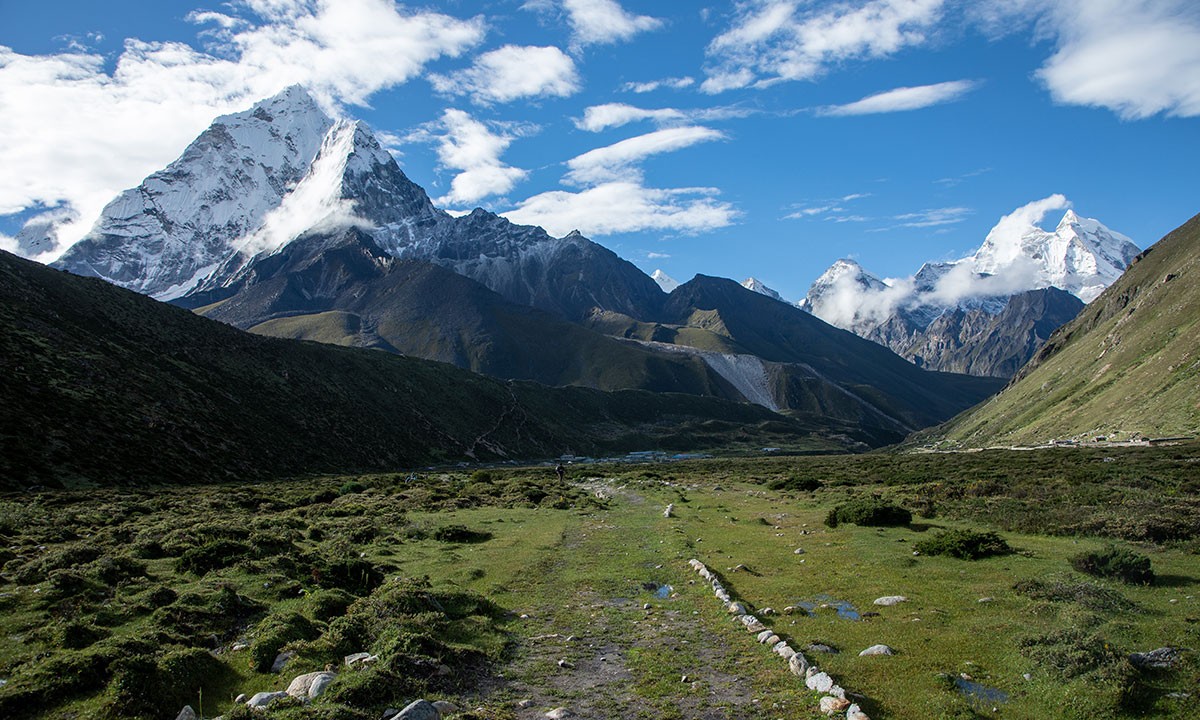
Even though you don’t have to partake in rigorous technical climbing on the slopes of the mountain, this trekking expedition is not like a hike in the backyard either. The physical preparation and training for this adventure to the highest base camp in the world is a must. With the right amount of preparation, this beautiful Himalayan exploration becomes a more enjoyable and comfortable experience rather than being a sour memory without adequate preparation and determination.
In general, it is recommended that you should start your preparation at least 6- 9 weeks before the adventure so that your body will get used to your workout routine. This way even the long draining hours of trek won't leave you exhausted and will boost your endurance level. Here are some exercises you could focus on during your preparation period:
Strength Training
There are several steep sections along this trek, you will be frequently climbing uphill and descending downhill frequently on the rugged terrains of the Himalayas. On top of that, you will be carrying your backpack and even simple trekking starts getting more challenging with the rise in elevation. Thus strength and endurance training will help you boost your physical prowess preparing you for a longer tiring adventure. You can include the following exercises in your strength training program.
- Push up
- Plank
- Deadlift
- Squat
- Lunge
- Pull up
- Bicep curl
- Bench press
- Calf raises
- Leg extension
- Jump squat
Cardiovascular Training
Cardiovascular is a very helpful exercise when it comes to increasing your stamina level and overall improving your body’s flexibility and oxygen-inhaling capabilities. Including these exercises in your preparation will make it easy for you to acclimatize effectively with the increasing altitude. Here are some cardiovascular exercises you can include in your training program:
- Cycling
- Jogging
- Swimming
- Lateral shuffle
- Jumping jack
- Cardio
- Jumping rope
- Rowing
Mental Preparation
Although a majority of trekkers focus on the physical training prospects which is of course the right way to train, however, many beginners overlook the mental preparation part. Determination and self-motivating factors also play a vital role when it comes to successfully completing any expeditions. Here are some mental preparations you could do to prepare for the difficulty factors of the trek:
- Leave your comfort zone
- Practicing controlled breathing
- Identify your fears and work on it
- Stay positive
- Visualize your expectations
- Stay focussed
- Practice stress-reducing exercises
Note: It is recommended that you should also focus on practice in natural steep terrains. Carry a backpack with significant weight and hike in your boots, this will not only prepare you to get used to carrying your belongings during the actual but will also help you to check the comfort level of your boots.
Food and Accommodation
The food and accommodation facilities along the Everest Base Camp trekking can be moderate to luxurious as it is one of the mainstream trekking routes in Nepal. However, the route is still in a remote region of the country that lacks proper transportation modes, so the luxurious services may not be on par with what you would expect in an urban destination. For accommodation, you will lodge on the teahouses along the trail that will offer warm cozy rooms, mostly shared rooms (2 or 3 beds per room. You will be provided a nice comfortable mattress, blanket, and pillow (although carrying your sleeping bag is recommended). As for the bathroom, it will be also common and shared, private bathroom facilities are not available in all of the teahouses. You will also be able to enjoy the hot showers along the trail, however, the services are limited as you ascend to the higher altitudes.
On the aspects of the eatery services, you will be able to relish the wide range of delicacies from traditional Nepali dishes to Tibetan-influenced as well continental menus. Throughout your expedition in the Everest region, you can expect the following menu options at the teahouses:
For Breakfast
- Bread
- Eggs
- Pancake
- Porridge
- Sandwich
- Soup
- Corn flakes
- Noodles
- Pudding
- Fruit
- Salad
- Pasta
- Papad
- Chapathi
- Paratha
For Lunch and Dinner
- Daal bhaat tarkari (boiled rice, lentils and vegetable)
- Pizza
- Momo
- Macronis and pasta
- Spaghetti
- Steak
- Pie
- Thukpa
- Shyakpa
- Riki kur
- Spring rolls
- Noodle
Drink and Beverages:
As for the drinks and beverages, you can enjoy several ranges of delicacies from a warm cup of coffee, tea, and cappuccino to canned juices and alcoholic beverages. Although alcoholic beverages are not recommended as they hinder the acclimatization procedure, you will be able to find them throughout the teahouses along the route.
In the case of drinking water, which is very crucial as you are recommended to drink at least 3- 4 liters in a day, you can buy bottled mineral water at the teahouses. You will also find tap water all over the trekking route but it is not safe to drink, however, you will be able to purify the water using purification solutions or tablets. The best and safest way to drink the water is to use the boiled water at the teahouses and purify it before drinking.
Note: In the Everest Base Camp trekking route, you also can choose from vegan and vegetarian options, every teahouse along the trail prepares both veg and non-veg meals, so requesting your preference will not be a big deal.
What to Pack for Everest Base Camp Trek With Helicopter Return?
.jpg)
For a comfortable and exhilarating experience in this trekking adventure of the Himalayas, you need to make sure that you are packing right. Although it is recommended for you to pack, you don’t want to miss out on the most basic essentials. Here are some packing suggestions that you might want to include in your checklist.
Clothes
- Brimmed hat or sun hat (sun protection)
- Knit hat, wool hat (for cold regions)
- Bandana/headscarf
- Neck gaiter
- Polypropylene sleeve shirts
- Lightweight thermal
- Down jacket (puffer)
- Waterproof/windproof jacket
- Insulated jacket
- Gloves light and woolen
- Hiking pants and shorts
- Fleece pant
- Thermal trouser
- Woolen pants (heavy)
- Several pairs of undergarments
Footwear
- Hiking boots (bring spare less)
- Waterproof gaiter (just in case)
- Socks (several pairs of thin, light, and wool for every climatic zone)
- Trainer or running shoes (for acclimatization day and short hikes)
- Crocks or slippers (you definitely will love giving freedom to your feet after long day of trekking)
Toiletries
- Small-sized mirror and nail clippers
- Toothbrush and toothpaste
- Lipbalm
- Quick drying towel
- Multi-purpose soaps
- Deodrandts
- Face and body moisturizers
- Toilet paper
- Face wipes
- Foot power
- Female hygiene products
- Small first aid kit (with all basic medications for general health issues)
- Personal medication (as prescribed and sufficient to last throughout the trek)
Accessories and Gadgets
- Headlamp (bring extra pairs of batteries)
- Sunglasses
- Sleeping bags (fours season bags)
- Trekking poles (collapsible)
- Daypack
- Water bottle
- Dry bags and stuff sacks for organized packing
- Portable batteries and solar charger
- Entertainment sets
- Board and card games
- Books and pens (you might wanna jump right into your memoir)
Note: You can easily buy or rent equipment from the gear shops in Kathmandu, especially in the Thamel sure. Just make sure to check the built and brand quality of the products as cheap products often can be fake.
Related Treks of This Region:


